Which of the following process helps the trichomes in preventing water loss?
Where companion cells helps in maintaining the pressure gradient in the sieve tubes.
Where plants absorb water through the roots and then give off water vapor through pores in their leaves.
Where activity of cork cambium builds pressure on the remaining layers peripheral to phellogen and ultimately these layers dies and slough off.
None of the above
Correct Answer :
B. Where plants absorb water through the roots and then give off water vapor through pores in their leaves.
Trichomes is a small hair or other outgrowth from the epidermis of a plant stem, typically unicellular and glandular. Trichomes that often cover the plant body are the result of divisions of epidermal cells. They may be branched or unbranched and soft or stiff. The trichomes help in preventing water loss due to transpiration. Transpiration is a process where plants absorb water through the roots and then give off water vapor through pores in their leaves.
Related Questions
Which one of the following statement is incorrect ?
- Epidermal cell has small amount of cytoplasm and a large vacuole.
- Waxy cuticle layer is absent in roots.
- Root hairs are unicellular, while stem hairs / trichomes are multicellular.
- Trichomes may be branched or unbranched, soft or stiff and prevent transpiration.
- Guard cells are dumbell shaped in dicots and beanshaped in monocots (e.g. grass).
Only (i)
Only (iv)
Only (iii)
Only (v)
The given figure shows T.S. of monocot stem. Identify the correct labelling of A to F marked in the given figure.
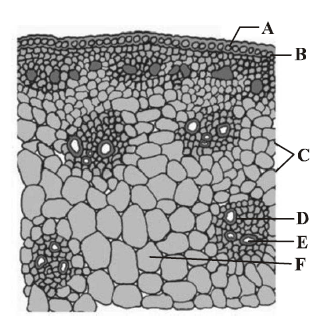
A Epidermis, B Hypodermis, C Vascular bundles, D Phloem, E Xylem, F Ground tissue
A Cuticle, B Epidermis, C Sclerenchymatous sheath, D Sclerenchymatous hypodermis, E Parenchymatous sheath, F Phloem
A Cuticle, B Epidermis, C Sclerenchymatous hypodermis, D Sclerenchymatous sheath, E Parenchymatous sheath, F Phloem
A Cuticle, B Epidermis, C Sclerenchymatous hypodermis, D Sclerenchymatous sheath, E Parenchymatous sheath, F Protoxylem
Gymnosperms are also called soft wood spermatophytes because they lack
cambium
phloem fibres
thick-walled tracheids
xylem fibres
The apical meristem of the root is present
in all the roots.
only in radicals.
only in tap roots.
only in adventitious roots.
A student was given a tissue to observe under the microscope. He observes the tissue and concludes that the tissue is a type of simple plant tissue and provides mechanical support to young stem and petiole of leaf.
Identify the tissue.
Parenchyma
Collenchyma
Sclerenchyma
Xylem parenchyma
In the given columns, column I contain structures of female reproductive system and column II contain its feature. Select the correct match.
| Column-I | Column-II |
|---|---|
| A. Lateral meristem | (i) Fascicular vascular cambium, interfascicular cambium and cork cambium. |
| B. Apical meristem | (ii) Produces dermal tissue, ground tissues and vascular tissue. |
| C. Bast fibres | (iii) Generally absent in primary phloem but found in secondary phloem. |
| D. Sap wood | (iv) Involved in the conduction of water and minerals from the root to leaf. |
A - (i), B - (ii), C - (iii), D - (iv)
A - (iii), B - (i), C - (ii), D - (iv)
A - (i), B - (iv), C - (iii), D - (ii)
A - (ii), B - (iv), C - (iii), D - (i)
Which of the following is responsible for the formation of an embryonic shoot called axillary bud?
Lateral meristem
Apical meristem
Intercalary meristem
Both
Read the following statements and answer the question.
- Cambium is very active and produces a large number of xylary elements having vessels with wider cavities.
- It is also called early wood.
- It is lighter in colour and has lower density.
Which type of wood is described by the above statements?
Sap wood
Heart wood
Spring wood
Autumn wood
Which of the following figure is a type of permanent tissue having many different types of cell?
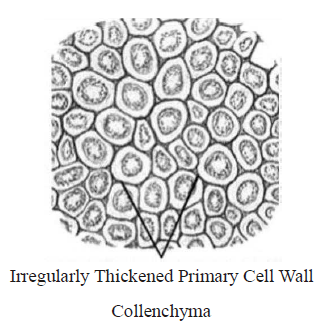
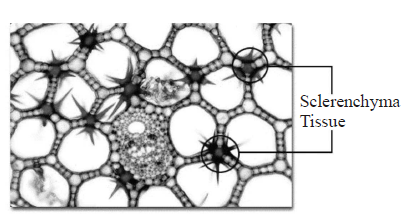
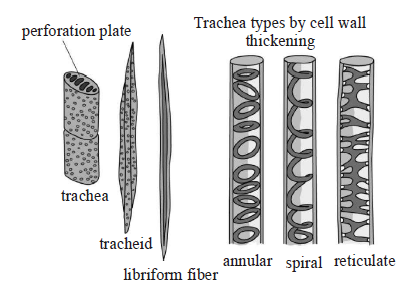
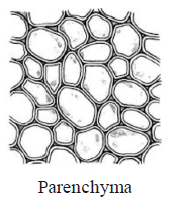
The __________ occurs in layers below the epidermis in dicotyledonous plants.
parenchyma
sclerenchyma
collenchyma
aerenchyma
Identify A, B and C in the given figure of shoot apical meristem
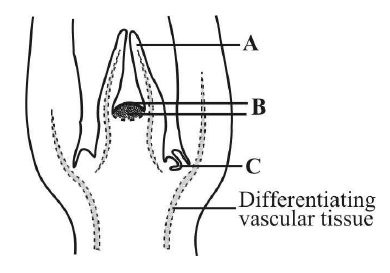
A Leaf primordium, B Shoot apical meristem, C Axillary bud
A Leaf primordium, B Shoot apical meristem, C Apical bud
A Root hair primordium, B Root apical meristem, C Axillary bud
A Root hair primordium, B Root apical meristem, C Terminal bud
Xylem functions as a conducting tissue for water and minerals from _________to the ______and__________.
roots, stems, leaves
stems, roots, leaves
leaves, stems, roots
leaves, stems, leaves
Tissue(s) present in an annual ring is/are
secondary xylem and phloem.
primary xylem and phloem.
secondary xylem only.
primary phloem and secondary xylem.
Cork cambium and vascular cambium are
the parts of secondary xylem and phloem.
the parts of pericycle.
lateral meristems.
apical meristems.
Read the following statements and answer the question.
- It has a sclerenchymatous hypodermis, a large number of scattered vascular bundles and a large parenchymatous ground tissue.
- Vascular bundles are conjoint and closed.
- Peripheral vascular bundles are generally smaller than the centrally located ones.
- Phloem parenchyma is absent, and water- containing cavities are present within the vascular bundles.
Which plant anatomy is being described by the above statements?
Dicotyledonous root
Monocotyledonous root
Dicotyledonous stem
Monocotyledonous stem
In an experiment, a student cut a transverse section of young stem of a plant which he has taken from his school garden.
After observing it under the microscope how would he ascertain whether it is a monocot stem or a dicot stem?
With the help of bulliform cells.
With the help of casparian strips.
With the help of vascular bundles.
With the help of stomatal apparatus.
As secondary growth proceeds, in a dicot stem, the thickness of
sapwood increases.
heartwood increase.
both sapwood and heartwood increases.
both sapwood and heartwood remains the same.
Match the terms given in column I with their features given in column II and choose the correct option.
| Column-I | Column-II |
|---|---|
| (Terms) | (Features) |
| A. Fibres | (i) Cells are living and thin walled with cellulosic cell wall, store food materials in the form of starch or fat |
| B. Sclereids | (ii) Main water conductive cells of the pteridophytes and the gymnosperms |
| C. Tracheids | (iii) Thick walled, elongated and pointed cells, generally occurring in groups |
| D. Vessels | (iv) Long cylindrical tube like structure and cells are devoid of protoplasm. Characteristic feature of angiosperms |
| E. Xylem parenchyma | (v) Reduced form of sclerenchyma cells with highly thickened lignified cellular walls that form small bundles of durable layers of tissue in most plants. |
A - (i), B - (ii), C - (iii), D - (iv), E - (v)
A - (iii), B - (v), C - (ii), D - (iv), E - (i)
A - (iii), B - (i), C - (v), D - (ii), E - (iv)
A - (v), B - (iv), C - (iii), D - (i), E - (ii)
A piece of wood having no vessels (trachea) must be belonged to
teak
mango
pine
palm
Match the followings and choose the correct option
| Column-I | Column-II |
|---|---|
| A. Cuticle | I. Guard cells |
| B. Bulliform cells | II. Outer layer |
| C. Stomata | III. Waxy layer |
| D. Epidermis | IV. Empty colourless cell |
A III, B IV, C I, D II
A I, B II, C III, D IV
A III, B II, C IV, D I
A III, B II, C I, D IV
A tissue is a group of cells which are
similar in origin, but dissimilar in form and function.
dissimilar in origin, form and function.
dissimilar in origin, but similar in form and function.
similar in origin, form and function.
In land plants, the guard cells differ from other epidermal cells in having
cytoskeleton.
mitochondria.
endoplasmic reticulum.
chloroplasts.
Apical, intercalary and lateral meristems are differentiated on the basis of
origin
function
position
development
Which of the following are present in monocot root ?
conjoint, collateral, open polyarch vascular bundle.
exodermis, endarch, tetrarch closed vascular bundles.
suberized exodermis, casparian strip, passage cells, cambium.
suberized exodermis, polyarch xylem, pith.
Why grafting is successful in dicots ?
In dicots vascular bundles are arranged in a ring.
Dicots have cambium for secondary growth.
In dicots vessels with elements are arranged end to end.
Cork cambium is present in dicots
Which one of the followings option shows the correct labelling of the parts marked as A, B, C and D in the given figure a lenticel?
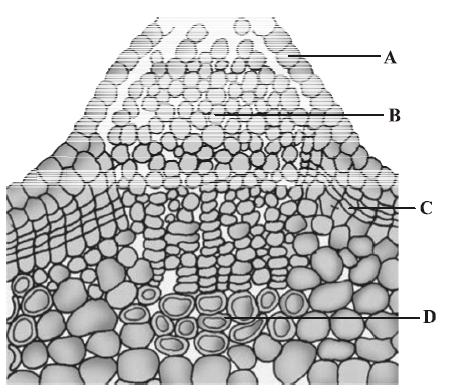
A Epidermis, B Secondary cortex, C Cork cambium, D Cork
A Pore, B Cork cambium, C Secondary cortex, D Cork
A Pore, B Cork, C Complimentary cells, D Cork cambium
A Epidermis, B Complimentary cells, C Cork cambium, D Secondary cortex
Match the names of the structures given in column-I with the functions given in column-II, choose the answer which gives the correct combination of the two columns :
| Column-I | Column-II |
|---|---|
| (Structure) | (Function) |
| A. Stomata | I. Protection of stem |
| B. Bark | II. Plant movement |
| C. Cambium | III. Secondary growth |
| D. Cuticle | IV. Transpiration |
| V. Prevent the loss of water | ... |
A V, B III, C I, D IV
A I, B IV, C V, D III
A II, B IV, C I, D III
A IV, B I, C III, D V
The given figure shows the T.S of dicot root. Some parts are marked as A, B, C, D, E, & F. Choose the option which shows the correct labelling of marked part.

A Epiblema, B Root hair, C Cortex, D Endodermis, E Pith, F Pericycle
A Cortex, B Pith, C Epiblema, D Endodermis, E Root hair, F Pericycle
A Epiblema, B Endodermis, C Cortex, D Root hair, E Pith, F Pericycle
A Cortex, B Epiblema, C Pith, D Endodermis, E Root hair, F Pericycle
Sieve tubes are suited for translocation of food because they possess
bordered pits.
no ends walls.
broader lumen and perforated cross walls.
no protoplasm.
When we peel the skin of a potato tuber, we remove
periderm
epidermis
cuticle
leaves
